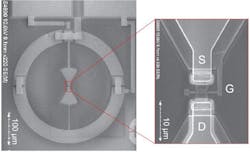TOPTICA’s TeraScan frequency-domain terahertz platform helps characterize next-generation terahertz detectors
So-called “TeraFETs” -- field-effect transistors with integrated antennas for terahertz detection -- are promising candidates for compact, chip-based yet broadband terahertz-radiation receivers. A team of researchers from Frankfurt University, Ferdinand-Braun Institute (both Germany), and Vilnius University (Lithuania) has managed to significantly improve the performance of TeraFETs using gallium nitride (GaN)-based high-electron mobility transistors (HEMTs).1 The sensitivity of the new devices was more than twofold higher than with previous GaN terahertz detectors.
The authors used a TeraScan 1550 frequency-domain terahertz platform from TOPTICA Photonics (Munich, Germany) as a precisely tunable terahertz source to characterize the new HEMT detectors over a broad frequency range. The Terascan 1550 combines distributed-feedback (DFB) diode lasers with gallium arsenide (GaAs) or indium gallium arsenide (InGaAs) photomixers to create terahertz radiation with the required properties.
The researchers showed the utility of their GaN TeraFETs for high-dynamic-range reflection imaging, using Schwarzschild optics to record a terahertz image through the plastics cover of a commercial cell phone at a frequency of 0.504 THz, yielding a dynamic range of greater than 40 dB. The team is working toward the creation of a broadband 12 × 12 pixel focal-plane array using the same AlGaN/GaN TeraFETs they reported on.
TOPTICA notes that its TeraScan platforms are well-established configurations for frequency-domain terahertz spectroscopy. The TeraScan 1550 has high terahertz power and dynamic range for numerous applications that include plastic inspection, materials research, gas sensing, and security.
Source: https://www.pressebox.de/pressemitteilung/toptica-photonics-ag/TOPTICAs-TeraScan-helps-characterize-next-generation-terahertz-detectors/boxid/1004723
REFERENCE:
1. Maris Bauer et al., IEEE Transactions on Terahertz Science and Technology (2019); https://ieeexplore.ieee.org/stamp/stamp.jsp?arnumber=8734725.
Got optics- and photonics-related news to share with us? Contact John Wallace, Senior Editor, Laser Focus World
Get more like this delivered right to your inbox

John Wallace | Senior Technical Editor (1998-2022)
John Wallace was with Laser Focus World for nearly 25 years, retiring in late June 2022. He obtained a bachelor's degree in mechanical engineering and physics at Rutgers University and a master's in optical engineering at the University of Rochester. Before becoming an editor, John worked as an engineer at RCA, Exxon, Eastman Kodak, and GCA Corporation.
